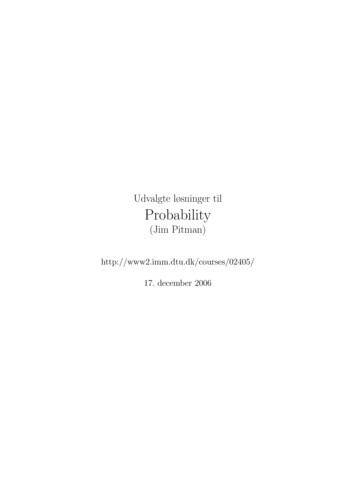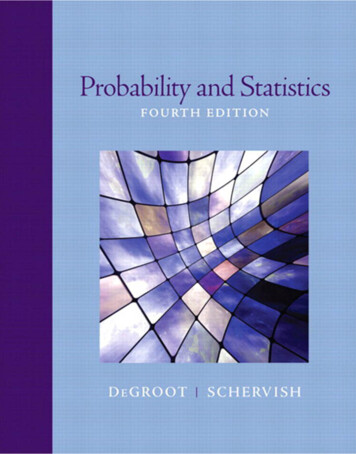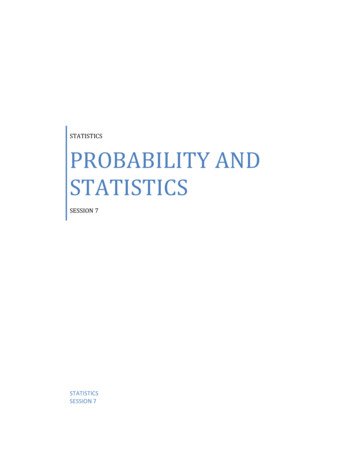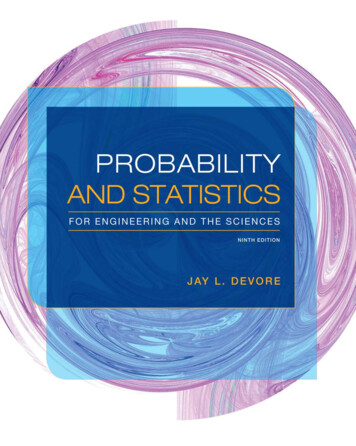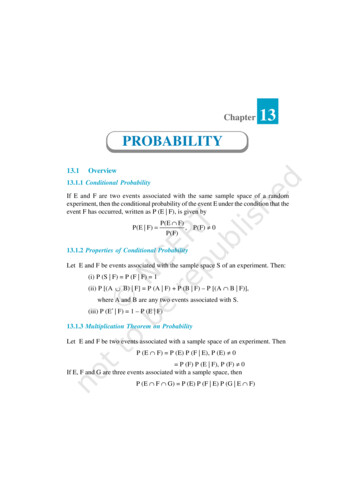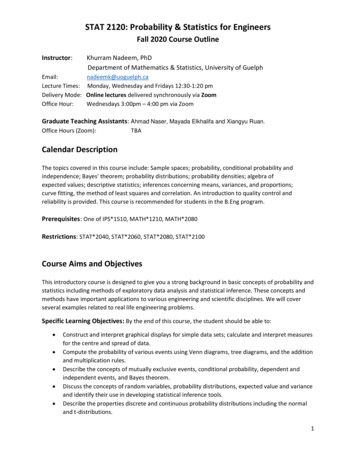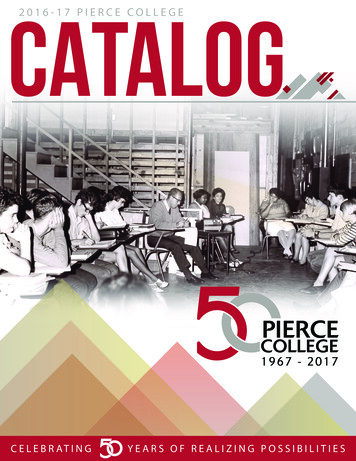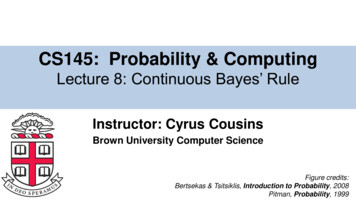
Transcription
NotesName:Date: Period:ProbabilityI. ProbabilityA. Vocabulary is the chance/ likelihood of some event occurring.Ex) The probability of rolling a 1 for a six-faced die is1. It is read as “1 in 6” or “1 out of 6”. In other6words, you have a 1 in 6 chance (or a 1 out of 6 chance) of rolling a 1 when you roll the die. are the possible results of an action. In other words, they are thepossibilities.Ex) There are six outcomes for rolling a die: 1, 2, 3, 4, 5, and 6.Check for UnderstandingWhat is the meaning behind the following sentences? What is the difference between the phrases, “in theory” and“in actuality”?“In theory, 30 students should be in class today. However, in actuality, only 28 students came to class today.II. Theoretical vs. Experimental Probability There are two types of probability:1) is the chance of an event occurring intheory. In other words, it is what you expect to happen in a perfect world.2) is the probability of an outcome based on anexperiment. In other words, it’s what happens in actuality or practice. Here are the two formulas for theoretical and experimental probability. Notice how they are basically thesame thing.Formula for Theoretical ProbabilityP (event) number of favorable outcomestotal number of possible outcomes
Formula for Experimental ProbabilityP (event) number of times an event occurstotal number of times the ex eriment is doneCheck for Understanding1) What is the difference between theoretical probability and experimental probability?2) If you run the coin flipping experiment 5,000 times, what can you expect the probability to be?Directions: Find the probability for one roll of a die. Write the probability as a fraction.Ex) P(3)Ex) P(3 or 4)Ex) P(even)Ex) P(4)Ex) P (1,2,or 3)Ex) P(not 3 or 4)Directions: Find the probability for selecting a letter at random from the word ARKANSAS. Write the probability asa fraction.Ex) P(K)Ex) P(N)Ex) P(vowel)Ex) P(K or N)Ex) P(A or S)Ex) P (N, R, or S)A. Experimental Probability Please remember that there are two types of probability:1) is the chance of an event occurring intheory. In other words, it is what you expect to happen or what should happen in a perfect world.2) is the probability of an outcome based on anexperiment. In other words, it’s what actually happens in the real world.
Check for Understanding*What is the difference between theoretical probability and experimental probability?ExamplesEx) Suppose you toss a coin 60 times and get tails 25 times. What is the experimental probability of getting tails andthe experimental probability of getting heads?P(tails) P(heads) Ex) An employee at Toys ‘R’ Us checked 400 toy cars. He found 12 defective cars. What is the experimentalprobability a toy car is defective?P(defective car) Ex) Suppose you go to the swap meet on Sunday. You ask 20 vendors if they make their products in Hawai’i. Only6 vendors say that they make their products in Hawai’i. What is the experimental probability of buying from avendor who makes his or her products in Hawai’i?P(products made in Hawai’i) Ex) Chris shoots 50 free throws. If he makes 42 free throws, what is the experimental probability that he misses thebasket?P(misses the basket) B. Theoretical ProbabilityExamplesEx) In a standard deck of 52 cards, there are 4 kings, 4 queens, and 4 jacks. What is the theoretical probability ofrandomly selecting one of these face cards from the deck?A)14B)12C)313D)413Ex) Sachiel has 5 orange and 10 green marbles in a bag. What is the theoretical probability of choosing an orangemarble from the bag?
Ex) Alina has 4 nickels, 2 dimes, and 6 quarters in her pocket. What is the theoretical probability that she willrandomly select a quarter from her pocket?A)12B)13C)14D)16Ex) There are six forks, four spoons, and eight knives in a drawer. What is the theoretical probability that someonereaching into the drawer will randomly select a fork?C. Theoretical Probability vs. Experimental ProbabilityEx) Kat conducted a probability experiment by flipping a coin 100 times. She recorded her results as shown below: 30 heads 70 tailsKat claimed that her results did not match the theoretical probability of flipping a coin. What should her results havebeen in order for the results to match the theoretical probability of flipping a coin?A) 20 heads and 80 tailsB) 40 heads and 60 tailsC) 80 heads and 20 tails D) 50 heads and 50 tailsEx) A weather reporter stated that the probability of rain last week as 4 out of 7 days. It rained on Monday, Tuesday,Wednesday, Friday, and Saturday last week. How did the reporter’s stated probability for rain last week compare tothe actual results?A) The probability of the rain matched the actual results.B) The probability of rain was less than the actual results.C) The probability of rain was greater than the actual results.D) The probability of rain would have matched the actual results if it had rained on Wednesday.Ex) Mr. Hayes tossed a coin 12 times to determine whether or not it would land on hands or tails. His results arebelow. Find the experimental probability of getting tails. Write your answer as a fraction, decimal, and a percent.T, H, H, H, T, T, T, T, H, H, H, H Fraction:Decimal:a) What is the theoretical probability that Mr. Hayes gets tails?b) Referring to this problem, which statement is true?1) The theoretical probability is greater than the experimental probability.2) The experimental probability is greater than the theoretical probability.Percent:
Ex) Mr. Stout tossed a coin 10 times to determine whether or not it would land on hands or tails. His results arebelow. Find the experimental probability of getting heads. Write your answer as a fraction, decimal, and a percent.T, T, T, H, T, T, H, H, H, TFraction:Decimal:Percent:a) What is the theoretical probability that Mr. Stout gets heads?b) Referring to this problem, which statement is true?1) The theoretical probability is greater than the experimental probability.2) The experimental probability is greater than the theoretical probability.D. Applying Probability to Larger Situations & Settings For some problems, you are expected find the probability of something occurring and then apply it to awhole group of people or a situation in which many trials are run.oTo solve these problems, you are going to have to take the probability you found and multiply itby the whole group of people or the number of trials that are run. It should look something likethis:Probability x whole group of peopleORprobability x the number of trials that are runExamplesEx) In preparation for her ice cream party, Emily surveyed 35 students at Pioneer Middle School about their favoriteice cream flavor. She found out that 7 of them like vanilla. If 210 students are expected to attend the ice cream party,about how many will prefer vanilla?Ex) Iyonna was chosen to dj the school dance. To prepare for the dance, Iyonna asked 40 students at Pionner MiddleSchool what songs they liked. She found out that 8 of the students liked Black and Yellow. If 300 students areexpected to attend the dance, about how many will like Black and Yellow?Ex) A student is taking a multiple-choice test that has 80 questions. Each question has 5 answer choices. If thestudent guesses randomly on every question, how many questions should the student expect to answer correctly?A) 12B) 16C) 32D) 40
Ex) Alyssa is playing a game in which she rolls a number cube with sides labeled 1 though 6. She rolls the cube 24times during the game. Based on the theoretical probability, how many times should he expect to roll a number lessthan 4?A) 12B) 14C) 16D) 24Ex) A fair number cube with faces numbered 1 through 6 was rolled 20 times. The cube landed with the number 4up 6 times. What is the difference between the experimental probability and the theoretical probability of thenumber 4 landing face up?Ex) A fair number cube with faces numbered 1 through 6 was rolled 50 times. The cube landed with the number 2up 10 times. What is the difference between the experimental probability and the theoretical probability of thenumber 2 landing face up?III. Independent vs. Dependent EventsCheck for Understanding1) What does “independent” mean?2) What does “dependent” mean?A. Vocabulary are events for which the occurrence of one eventdoes not affect the probability of the occurrence of the other.Probability of Independent EventsP (A, then B) P(A) P(B)For two independent events A and B, the probability of both events occurring is theproduct of the probabilities of each event occurring.
are events for which the occurrence of one eventaffects the probability of the occurrence of the other.Probability of Dependent EventsP (A, then B) P(A) P(B after A)For two dependent events A and B, the probability of both events occurring is theproduct of the probability of the first event and the probability that, after the first*Notice how you are doing the same thing for both independent and dependent events. You are multiplying the firstevent,thebysecondoccurs.probabilitythe secondeventprobability.B. Figuring out the Difference between Independent and Dependent Events To help you figure out whether you have an independent or dependent event, you should ALWAYS askyourself the following question:***Is the probability of the second event directly affected by the probability of the first event? If the answer is no, then it is an .o Here are some key words/ situations that will tell you that you have an independentevent:1) Rolling a number cube(s) or flipping a coin(s)2) Taking an (item) out and replacing the (item)3) Taking an (item) out and putting the (item) back If the answer is yes, then it is a .o Here are some key words/ situation that will tell you that you have a dependentevent:1) Taking an (item) out and not putting it backa.without replacing the (item) b.without putting the (item) back .ExamplesDirections: Please say whether the event is independent and dependent and explain why.Ex) You roll a number cube. You roll it again.
Ex) You select a card from a deck. Without putting the card back, you select a second card.Ex) You flip a coin two times. On your first flip, it lands on heads. What is the probability that the coin will land onheads on your second flip?Ex) You have 10 marbles in a bag, of which 6 are red and 4 are blue. You pull a red marble randomly out of the bag.Without replacing the marble, you pull another marble out of the bag. What is the probability that the second marblewill also be red?Ex) You pick a marble from a bag containing 2 blue marbles, 5 red marbles, and 3 purple marbles. You replace themarble and select a second marble.Ex) You select a card from a deck. You put the card back in the deck and then select a second card.Check for Understanding1) Explain why this is a dependent event: You select a card randomly from a deck of 52 cards, and without puttingthe card back, you select another card from the deck.2) Explain why this is an independent event: You pick a marble from a bag containing 20 marbles. You replace themarble and select a second marble.C. Solving Independent and Dependent Events Before you start any of these problems, you need to figure out whether or not you have an independent ordependent event.ExamplesDirections: You roll a number cube (with sides labeled 1 through 6) twice. What is the probability that you roll eachpair of numbers?*Before you answer the questions below, is this an independent or dependent event?Ex) P(6, then 5)Ex) P(6, then 2)Ex) P(1, then 2 or 5)
Ex) P(3, then a number less than 4)Ex) P(even, then 1 or 6)Ex) P(even, odd)Directions: You select a card at random from the cards below. Without replacing the card, you select asecond card. Find the probability of selecting each set of letters.PREALGEBRA*Before you answer the questions below, is this an independent or dependent event?Ex) P(P, then G)Ex) P(B, then A)Ex) P(G, then A or R)Directions: You pick a marble from a bag containing 1 green marble, 4 red marbles, 2 yellow marbles,and 3 black marbles. You replace the first marble then select a second one. Find each probability.*Before you answer the questions below, is this an independent or dependent event?Ex) P(red, then yellow)Ex) P(red, then black)Directions: Daniel has 5 blue socks, 4 black socks, and 3 white socks. He selects one sock at random. Withoutreplacing the sock, he selects a second sock at random. Find each probability.*Before you answer the questions below, is this an independent or dependent event?Ex) P(black, then white)Ex) P(white), then P(blue)Ex) P(black, then black)Ex) P(blue, then blue)Ex) When two coins are tossed at the same time, what is the theoretical probability of an outcome of one head andone head?A)14B)13C)12D)34
Ex) When three coins are tossed at the same time, what is the theoretical probability of an outcome of one head, onetail, and one head?A)14B)13C)12D)18Ex) When two number cubes are rolled at the same time, what is the theoretical probability of rolling a 1 and 5?A)12B)136C)18D)536IV. Spinners A is a circle that is divided up into different parts according to category.The categories can be numbers, letters, colors, money, etc. Spinners are commonly used in games involvingprobability.oA famous example of a spinner is the game show, Wheel of Fortune!A. Problems involving SpinnersEx) Mrs. Watkins is using the spinner below to play a game.a) What is the theoretical probability of the spinner landing on the letter B?b) If the pointer is spun a total of 80 times, how many times can she expect the pointer to land on the letter B?
Ex) Oneka is using the spinner below to play a game.a) What is the theoretical probability of the spinner landing on 1?b) If the pointer is spun a total of 60 times, how many times can she expect the pointer to land on 1?B. Problems involving Two SpinnersEx) Daniella is using the two spinners below to play a game.If Daniella spins both spinners at the same time, what is the probability that she spins a 3 for the first spinner and a12 for the second spinner?Ex) Brian has the spinner shown below and a coin.For an experiment, he spins the spinner and then tosses the coin. He does the experiment 64 times. How many timesshould Brian expect to spin a 4 and then have the coin land on heads?Ex) Let’s say you toss a coin and roll a number cube 144 times. What is the expected result of getting tails and anumber 4?
V. Sample Size A is a part of a group you use to make estimates about that group. Theyour , the more reliable your estimates will be. A is when you select members of the group atrandom. It is likely to be of the whole group. Here are two examples of taking a sample: Mrs. Watkins decides to randomly survey 10 out of the 90 students she teaches. The 10 students areconsidered the sample and their answers can be used to represent the entire 90 students she teaches. Mrs. Watkins is rolling a number cube 20 times to see how many times it will land on 6. The numberof trials (20 times) represents the sample size. The more trials she runs (the larger the sample size), themore accurate her results will be.A. Theoretical vs. Experimental Probability The more trials of an experiment you run, the closer your probability will get to theprobability. Similarly, the larger the of an experiment, the moreaccurate the results will be. This means that the experimental probability will get closer to thetheoretical probability (to be more accurate).ExamplesEx) The expected probability of rolling an even number in 1 roll of a fair cube with faces numbered 1 through 6 is13. When the cube was rolled 20 times, an even number came up 15 times, or of the time. When the same cube241was rolled 100 times, an even number came up 51 times, or almost the time. Why are the actual results closer to21the expected probability of when rolling the cube 100 times?2A) A larger sample size was used.C) The thrower disregarded the odd rolls.B) The 100 tosses were controlled better.D) The cube was rolled an even number of times.Ex) Twenty students choose a piece of fruit from a list of 4 fruits: apple, banana, grape, and pear. The theoreticalprobability that a student will choose a banana is 0.25. Only 1 student chooses a banana. How can the experimentalprobability get closer to the theoretical probability?A) Use a larger sample size of students.C) Provide more choices of fruit.B) Use a smaller sample size of students.D) Only give two choices of fruit.
Ex) Fifty students choose a piece of fruit from a list of 4 fruits: apple, banana, grape, and pear. The theoreticalprobability that a student will choose an apple is 0.25. Only 1 student chooses an apple. How can the experimentalprobability get closer to the theoretical probability?A) Use a larger sample size of students.C) Provide more choices of fruit.B) Use a smaller sample size of students.D) Only give two choices of fruit.Ex) Mr. Nystrom is conducting an experiment which involves rolling a pair of number cubes numbered 1 through 6.Rolling the sum of 12 is predicted to occur only 1 out of every 36 times. If Mr. Nystrom has already rolled four 12sout of 10 rolls, how might he get his results closer to the predicted results?A) Roll the number cubes 100 or more times.C) Shake the number cubes harder.B) Roll the number cubes 10 more times.D) Ignore the next 12s that occur.Ex) Jayden tossed a fair number cube with faces numbered 1 through 6 a total of 30 times. The number 5 came up 8times. How do Jayden’s results compare to the expected probability of getting the number 5 on 30 tosses?A) The outcome of 5 occurred more often than expected.B) The outcome of 5 occurred less often than expected.C) The outcome of 5 occurred 7 more times than expected.D) The outcome of 5 occurred exactly the same number of times as expected.Ex) Caleb tossed a fair number cube with faces numbered 1 through 6 a total of 36 times. The number 6 came up 10times. How do Caleb’s results compare to the expected probability of getting the number 6 on 36 tosses?A) The outcome of 6 occurred more often than expected.B) The outcome of 6 occurred less often than expected.C) The outcome of 6 occurred 7 more times than expected.D) The outcome of 6 occurred exactly the same number of times as expected.Ex) The theoretical probability of tossing two heads when tossing a pair of coins is 0.25. When the pair of coins wastossed 20 times, two heads came up only 2 times. Which procedure would result in an experimental probability thatis closer to the theoretical probability?A) Toss the coins more than 20 times.C) Toss the coins fewer than 20 times.B) Toss three coins instead of two coins.D) Count only those tosses that result in two heads or two tails.Ex) The theoretical probability of tossing two heads when tossing a pair of coins is 0.25. When the pair of coins wastossed 40 times, two heads came up only 5 times. Which procedure would result in an experimental probability thatis closer to the theoretical probability?A) Toss the coins more than 40 times.C) Toss the coins fewer than 40 times.B) Toss three coins instead of two coins.D) Count only those tosses that result in two heads or two tails.
Ex) There are six forks, four spoons, and eight knives in a drawer. What is the theoretical probability that someone reaching into the drawer will randomly select a fork? C. Theoretical Probability vs. Experimental Probability Ex) Kat conducted a probability experiment by flipping a coin 100 times. She recorded her results as shown below:
